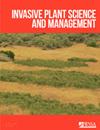A ranching economic analysis of ventenata (Ventenata dubia) control in northeast Wyoming
IF 1.2
4区 生物学
Q3 PLANT SCIENCES
引用次数: 0
Abstract
Abstract Invasive species pose a threat to the livelihoods of many people living on rangelands of the western United States. Invasive species impact many ecosystem goods and services of the areas they invade and represent one of the largest causes of habitat degradation. On private ranches, economic analyses often find that conservation practices, such as invasive species control, are not economically viable, in contrast to what is found at the landscape scale. In northeast Wyoming, ventenata [Ventenata dubia (Leers) Coss.] is a relatively new invader in the Great Plains ecoregion that threatens forage production on ranches. Our objective was to explore the economic costs of V. dubia for two options available to a ranch operation: purchasing extra hay to offset losses in forage and controlling V. dubia with herbicide. Using a partial budget analysis, we compare these two options in three invasion scenarios using a range of forage utilization rates and discount rates. Controlling V. dubia with herbicide was a cheaper option compared with purchasing additional hay in many cases. In fact, at 50% utilization, it is cheaper to control V. dubia in all of our scenarios at all discount rates given our assumptions. For lower grazing utilization rates, it becomes cheaper to purchase hay in some cases other than in our worst-case invasion scenario. In these cases, coordination among ranchers is needed to effectively control V. dubia. There are many ranch-specific differences that may make a different option more feasible, and we did not explore options of reducing herd sizes. However, our results suggest that controlling V. dubia can be an economically viable option under certain circumstances. Additional assistance in the form of a cost-share program, and facilitation of coordination is needed to overcome the difficulties of private management of invasive species.怀俄明州东北部ventenata (ventenata dubia)控制的牧场经济分析
入侵物种对生活在美国西部牧场上的许多人的生计构成威胁。入侵物种影响其入侵地区的许多生态系统产品和服务,是造成栖息地退化的最大原因之一。在私人牧场上,经济分析经常发现,与在景观规模上发现的情况相比,诸如入侵物种控制等保护措施在经济上是不可行的。在怀俄明州东北部,文特纳塔[文特纳塔dubia (Leers) Coss。是大平原生态地区一种相对较新的入侵者,威胁着牧场的饲料生产。我们的目标是探讨dubia的经济成本,为牧场经营提供两种选择:购买额外的干草以抵消饲料的损失和用除草剂控制dubia。使用部分预算分析,我们使用牧草利用率和贴现率的范围比较了三种入侵情景下的这两种选择。在许多情况下,与购买额外的干草相比,用除草剂控制dubia是一种更便宜的选择。事实上,在50%的利用率下,在所有情况下控制V. dubia在所有假设的贴现率下都更便宜。对于较低的放牧利用率,在某些情况下,购买干草比我们最坏的入侵情况更便宜。在这些情况下,需要牧场主之间的协调来有效控制dubia弧菌。有许多牧场特有的差异,可能使不同的选择更可行,我们没有探索减少畜群规模的选择。然而,我们的研究结果表明,在某些情况下,控制dubia弧菌在经济上是可行的选择。为了克服入侵物种私人管理的困难,需要以费用分担计划的形式提供额外的援助,并促进协调。
本文章由计算机程序翻译,如有差异,请以英文原文为准。
求助全文
约1分钟内获得全文
求助全文
来源期刊

Invasive Plant Science and Management
PLANT SCIENCES-
CiteScore
2.20
自引率
9.10%
发文量
24
审稿时长
6-12 weeks
期刊介绍:
Invasive Plant Science and Management (IPSM) is an online peer-reviewed journal focusing on fundamental and applied research on invasive plant biology, ecology, management, and restoration of invaded non-crop areas, and on other aspects relevant to invasive species, including educational activities and policy issues. Topics include the biology and ecology of invasive plants in rangeland, prairie, pasture, wildland, forestry, riparian, wetland, aquatic, recreational, rights-of-ways, and other non-crop (parks, preserves, natural areas) settings; genetics of invasive plants; social, ecological, and economic impacts of invasive plants and their management; design, efficacy, and integration of control tools; land restoration and rehabilitation; effects of management on soil, air, water, and wildlife; education, extension, and outreach methods and resources; technology and product reports; mapping and remote sensing, inventory and monitoring; technology transfer tools; case study reports; and regulatory issues.
 求助内容:
求助内容: 应助结果提醒方式:
应助结果提醒方式:


